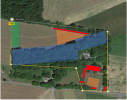At 5.7 he should be able to grow most food plot seeds, they may not exceed their potential, but most crops will grow decently.
He had a ph of 5.7 a year ago, he added 250# last year, and is planning on adding 320 more pounds this year that is 580# on 1/3 of an acre. By the average needed inputs to raise the PH 1 point for an acre is 2000#, it only needs roughly 650# for 1/3 acre. I would say his amendments would get him in the sweet spot. No need to have an ideal 7ph, since most food plot seeds ask for 6-6.5 anyhow.
Those of us that have small food plots need to buy peletized lime, which isnt cheap, and it requires physical labor and time. Spreading it out over a couple years makes it easier. I know for the bigger plots, where you call the ag department in, and they just spread all the lime for you, and the only work you needed to do was make a phone call, then it wouldnt make sense to do half of what is needed. But for those of us that have to go to a store, pay over $300 per ton, load it into our vehicles, drive to our land, unload it, more then likely load it onto an ATV, or trailer, then fill a small spreader, then spread it 50-100 pounds at a time, it can take a solid weekend to spread a ton of lime. Some times small plots take a lot of work, much more physical labor then lare plots, because if you are doing large plots, you probably have larger equipment.
I started from scratch, with a hand garden rake and a hoe, I would have to carry everything I needed into the woods a couple hundred yards, lime, fertilizer, seed, tools, I forsure didnt do a soil test, and ammend everything as needed, and I got successful plots even then.

